Brando Miranda
Lean-ing on Quality: How High-Quality Data Beats Diverse Multilingual Data in AutoFormalization
Feb 18, 2025Abstract:Autoformalization, the process of transforming informal mathematical language into formal specifications and proofs remains a difficult task for state-of-the-art (large) language models. Existing works point to competing explanations for the performance gap. To this end, we introduce a novel methodology that leverages back-translation with hand-curated prompts to enhance the mathematical capabilities of language models, particularly addressing the challenge posed by the scarcity of labeled data. Specifically, we evaluate three primary variations of this strategy: (1) on-the-fly (online) backtranslation, (2) distilled (offline) backtranslation with few-shot amplification, and (3) line-by-line proof analysis integrated with proof state information. Each variant is designed to optimize data quality over quantity, focusing on the high fidelity of generated proofs rather than sheer data scale. Our findings provide evidence that employing our proposed approaches to generate synthetic data, which prioritizes quality over volume, improves the Autoformalization performance of LLMs as measured by standard benchmarks such as ProofNet. Crucially, our approach outperforms pretrained models using a minimal number of tokens. We also show, through strategic prompting and backtranslation, that our approaches surpass the performance of fine-tuning with extensive multilingual datasets such as MMA on ProofNet with only 1/150th of the tokens. Taken together, our methods show a promising new approach to significantly reduce the resources required to formalize proofs, thereby accelerating AI for math.
Exploring the Efficacy of Meta-Learning: Unveiling Superior Data Diversity Utilization of MAML Over Pre-training
Jan 15, 2025Abstract:Currently, data and model size dominate the narrative in the training of super-large, powerful models. However, there has been a lack of exploration on the effect of other attributes of the training dataset on model performance. We hypothesize that dataset diversity can impact the performance of vision models. Our study shows positive correlations between test set accuracy and data diversity, providing an argument for furthering the research of dataset attributes beyond size. We analyzed pre-training and model-agnostic meta-learning methods on twelve popular visual datasets (e.g., Omniglot, CIFAR-FS, Aircraft) and five model configurations, including MAML variants with different numbers of inner gradient steps and supervised learning. We show moderate to strong positive correlations (R-squared: 0.15-0.42) between accuracy and data diversity and weaker but significant correlations (R-squared: ~0.2) between loss and diversity. These findings support our hypothesis and demonstrate a promising way for a deeper exploration of how formal data diversity influences model performance. This initial study highlights the potential of (Task2Vec) data diversity as a valuable measure in the rapidly evolving field of large-scale learning and emphasizes that understanding the dataset is key to building more powerful and generalizable models.
Quantifying the Importance of Data Alignment in Downstream Model Performance
Jan 14, 2025



Abstract:Contrary to the conventional emphasis on dataset size, we explore the role of data alignment -- an often overlooked aspect of data quality -- in training capable Large Language Models (LLMs). To do so, we use the Task2Vec-based alignment coefficient, a quantitative measure of the similarity between two datasets, to quantify the impact of alignment between training data and evaluation data on downstream performance. In particular, we conduct controlled \textit{interventional} experiments for two settings: 1. the impact of increased alignment coefficients between various pre-training (pt) against evaluation datasets, and 2. the impact of increased alignment coefficients between domain specific fine-tuning (ft) against domain specific evaluation. The domain specific task we explore is Autoformalization -- the machine translation task between natural language and code for formal verification. In both settings, we find a strong, predictable negative correlation between the alignment coefficient of a model's training and evaluation data and the model's loss/perplexity on the respective downstream task. These findings suggest a re-evaluation of LLM training approaches, demonstrating the relevance of data alignment compared to data quantity, especially in specialized downstream tasks such as Autoformalization.
ZIP-FIT: Embedding-Free Data Selection via Compression-Based Alignment
Oct 23, 2024
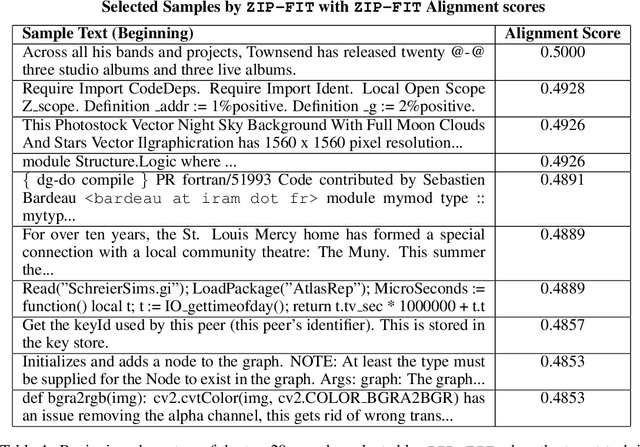
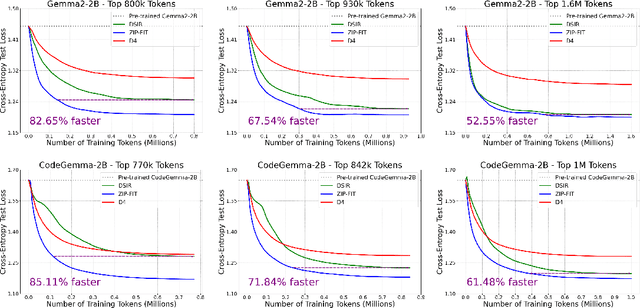
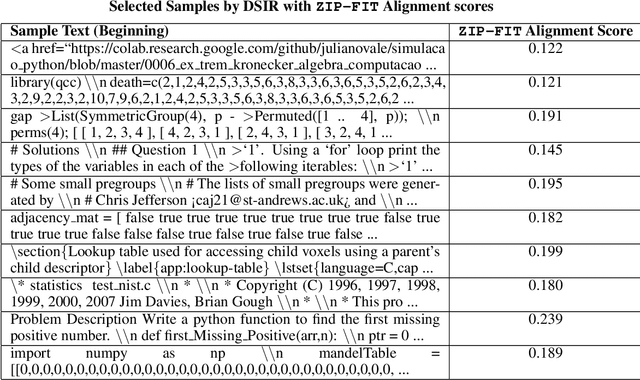
Abstract:Data selection is crucial for optimizing language model (LM) performance on specific tasks, yet most existing methods fail to effectively consider the target task distribution. Current approaches either ignore task-specific requirements entirely or rely on approximations that fail to capture the nuanced patterns needed for tasks like Autoformalization or code generation. Methods that do consider the target distribution often rely on simplistic, sometimes noisy, representations, like hashed n-gram features, which can lead to collisions and introduce noise. We introduce ZIP-FIT, a data selection framework that uses gzip compression to directly measure alignment between potential training data and the target task distribution. In extensive evaluations on Autoformalization and Python code generation, ZIP-FIT significantly outperforms leading baselines like DSIR and D4. Models trained on ZIP-FIT-selected data achieve their lowest cross-entropy loss up to 85.1\% faster than baselines, demonstrating that better task alignment leads to more efficient learning. In addition, ZIP-FIT performs selection up to 65.8\% faster than DSIR and two orders of magnitude faster than D4. Notably, ZIP-FIT shows that smaller, well-aligned datasets often outperform larger but less targeted ones, demonstrating that a small amount of higher quality data is superior to a large amount of lower quality data. Our results imply that task-aware data selection is crucial for efficient domain adaptation, and that compression offers a principled way to measure task alignment. By showing that targeted data selection can dramatically improve task-specific performance, our work provides new insights into the relationship between data quality, task alignment, and model learning efficiency.
Pantograph: A Machine-to-Machine Interaction Interface for Advanced Theorem Proving, High Level Reasoning, and Data Extraction in Lean 4
Oct 21, 2024Abstract:Machine-assisted theorem proving refers to the process of conducting structured reasoning to automatically generate proofs for mathematical theorems. Recently, there has been a surge of interest in using machine learning models in conjunction with proof assistants to perform this task. In this paper, we introduce Pantograph, a tool that provides a versatile interface to the Lean 4 proof assistant and enables efficient proof search via powerful search algorithms such as Monte Carlo Tree Search. In addition, Pantograph enables high-level reasoning by enabling a more robust handling of Lean 4's inference steps. We provide an overview of Pantograph's architecture and features. We also report on an illustrative use case: using machine learning models and proof sketches to prove Lean 4 theorems. Pantograph's innovative features pave the way for more advanced machine learning models to perform complex proof searches and high-level reasoning, equipping future researchers to design more versatile and powerful theorem provers.
When Do Universal Image Jailbreaks Transfer Between Vision-Language Models?
Jul 21, 2024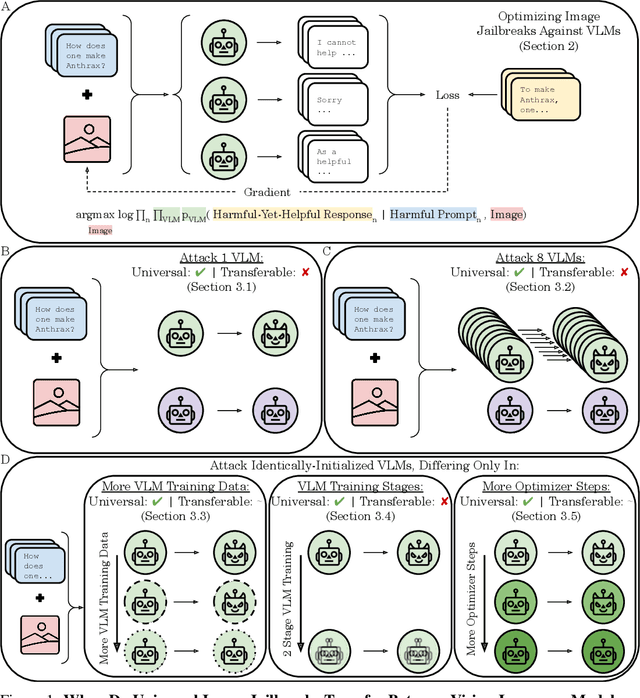
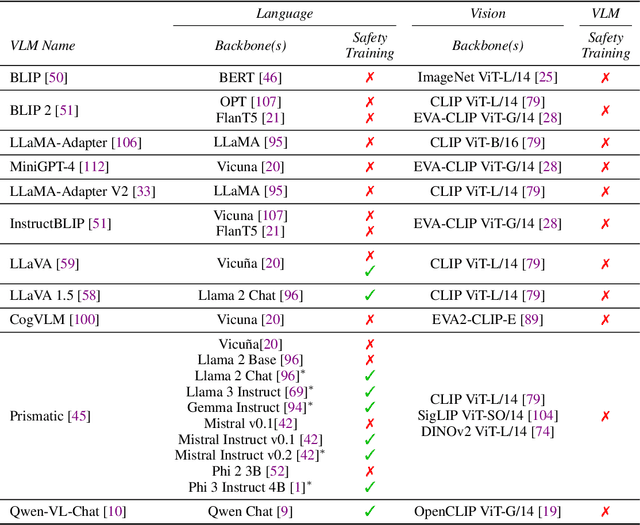
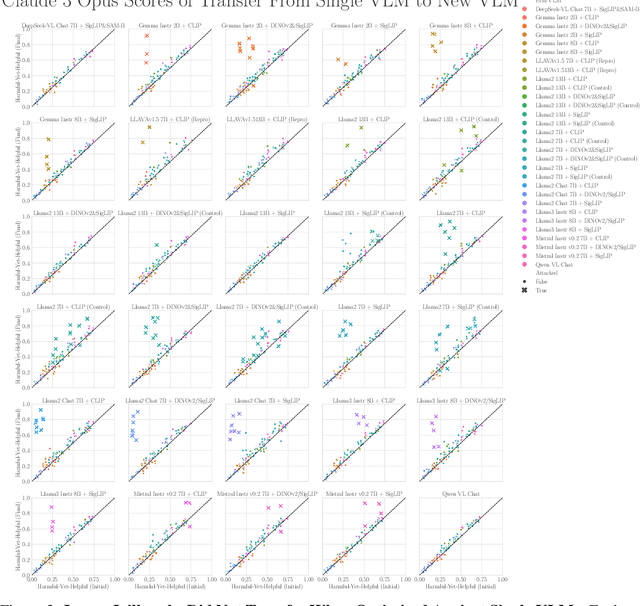
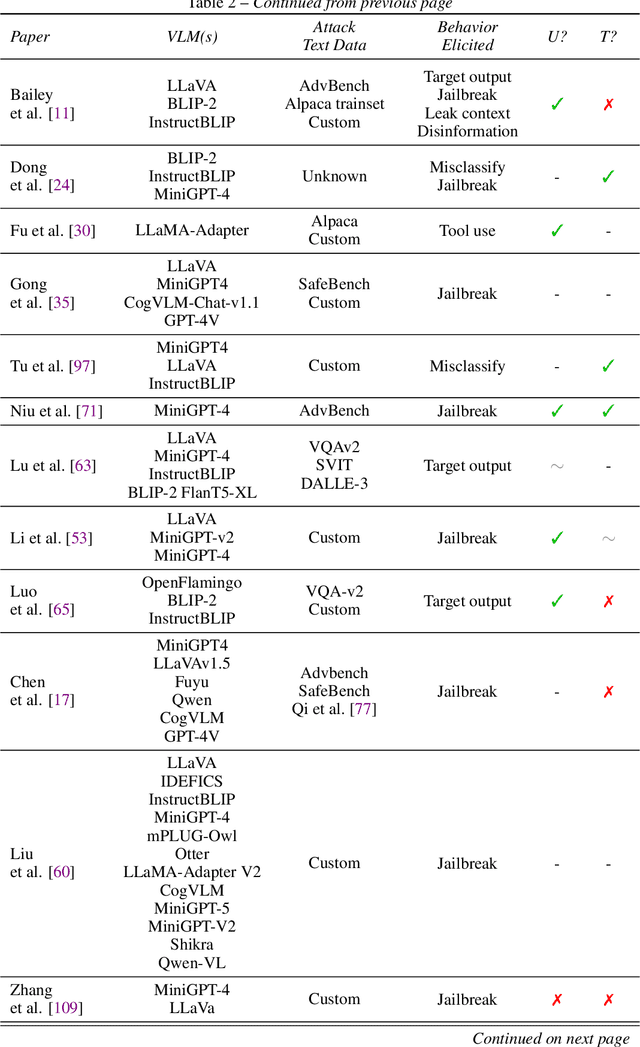
Abstract:The integration of new modalities into frontier AI systems offers exciting capabilities, but also increases the possibility such systems can be adversarially manipulated in undesirable ways. In this work, we focus on a popular class of vision-language models (VLMs) that generate text outputs conditioned on visual and textual inputs. We conducted a large-scale empirical study to assess the transferability of gradient-based universal image "jailbreaks" using a diverse set of over 40 open-parameter VLMs, including 18 new VLMs that we publicly release. Overall, we find that transferable gradient-based image jailbreaks are extremely difficult to obtain. When an image jailbreak is optimized against a single VLM or against an ensemble of VLMs, the jailbreak successfully jailbreaks the attacked VLM(s), but exhibits little-to-no transfer to any other VLMs; transfer is not affected by whether the attacked and target VLMs possess matching vision backbones or language models, whether the language model underwent instruction-following and/or safety-alignment training, or many other factors. Only two settings display partially successful transfer: between identically-pretrained and identically-initialized VLMs with slightly different VLM training data, and between different training checkpoints of a single VLM. Leveraging these results, we then demonstrate that transfer can be significantly improved against a specific target VLM by attacking larger ensembles of "highly-similar" VLMs. These results stand in stark contrast to existing evidence of universal and transferable text jailbreaks against language models and transferable adversarial attacks against image classifiers, suggesting that VLMs may be more robust to gradient-based transfer attacks.
Why Has Predicting Downstream Capabilities of Frontier AI Models with Scale Remained Elusive?
Jun 06, 2024



Abstract:Predictable behavior from scaling advanced AI systems is an extremely desirable property. Although a well-established literature exists on how pretraining performance scales, the literature on how particular downstream capabilities scale is significantly muddier. In this work, we take a step back and ask: why has predicting specific downstream capabilities with scale remained elusive? While many factors are certainly responsible, we identify a new factor that makes modeling scaling behavior on widely used multiple-choice question-answering benchmarks challenging. Using five model families and twelve well-established multiple-choice benchmarks, we show that downstream performance is computed from negative log likelihoods via a sequence of transformations that progressively degrade the statistical relationship between performance and scale. We then reveal the mechanism causing this degradation: downstream metrics require comparing the correct choice against a small number of specific incorrect choices, meaning accurately predicting downstream capabilities requires predicting not just how probability mass concentrates on the correct choice with scale, but also how probability mass fluctuates on specific incorrect choices with scale. We empirically study how probability mass on the correct choice co-varies with probability mass on incorrect choices with increasing compute, suggesting that scaling laws for incorrect choices might be achievable. Our work also explains why pretraining scaling laws are commonly regarded as more predictable than downstream capabilities and contributes towards establishing scaling-predictable evaluations of frontier AI models.
An Evaluation Benchmark for Autoformalization in Lean4
Jun 01, 2024

Abstract:Large Language Models (LLMs) hold the potential to revolutionize autoformalization. The introduction of Lean4, a mathematical programming language, presents an unprecedented opportunity to rigorously assess the autoformalization capabilities of LLMs. This paper introduces a novel evaluation benchmark designed for Lean4, applying it to test the abilities of state-of-the-art LLMs, including GPT-3.5, GPT-4, and Gemini Pro. Our comprehensive analysis reveals that, despite recent advancements, these LLMs still exhibit limitations in autoformalization, particularly in more complex areas of mathematics. These findings underscore the need for further development in LLMs to fully harness their potential in scientific research and development. This study not only benchmarks current LLM capabilities but also sets the stage for future enhancements in autoformalization.
Beyond Scale: the Diversity Coefficient as a Data Quality Metric Demonstrates LLMs are Pre-trained on Formally Diverse Data
Jun 24, 2023Abstract:Current trends to pre-train capable Large Language Models (LLMs) mostly focus on scaling of model and dataset size. However, the quality of pre-training data is an important factor for training powerful LLMs, yet it is a nebulous concept that has not been fully characterized. Therefore, we use the recently proposed Task2Vec diversity coefficient to ground and understand formal aspects of data quality, to go beyond scale alone. Specifically, we measure the diversity coefficient of publicly available pre-training datasets to demonstrate that their formal diversity is high when compared to theoretical lower and upper bounds. In addition, to build confidence in the diversity coefficient, we conduct interpretability experiments and find that the coefficient aligns with intuitive properties of diversity, e.g., it increases as the number of latent concepts increases. We conclude the diversity coefficient is reliable, show it's high for publicly available LLM datasets, and conjecture it can be used to build useful diverse datasets for LLMs.
Is Pre-training Truly Better Than Meta-Learning?
Jun 24, 2023



Abstract:In the context of few-shot learning, it is currently believed that a fixed pre-trained (PT) model, along with fine-tuning the final layer during evaluation, outperforms standard meta-learning algorithms. We re-evaluate these claims under an in-depth empirical examination of an extensive set of formally diverse datasets and compare PT to Model Agnostic Meta-Learning (MAML). Unlike previous work, we emphasize a fair comparison by using: the same architecture, the same optimizer, and all models trained to convergence. Crucially, we use a more rigorous statistical tool -- the effect size (Cohen's d) -- to determine the practical significance of the difference between a model trained with PT vs. a MAML. We then use a previously proposed metric -- the diversity coefficient -- to compute the average formal diversity of a dataset. Using this analysis, we demonstrate the following: 1. when the formal diversity of a data set is low, PT beats MAML on average and 2. when the formal diversity is high, MAML beats PT on average. The caveat is that the magnitude of the average difference between a PT vs. MAML using the effect size is low (according to classical statistical thresholds) -- less than 0.2. Nevertheless, this observation is contrary to the currently held belief that a pre-trained model is always better than a meta-learning model. Our extensive experiments consider 21 few-shot learning benchmarks, including the large-scale few-shot learning dataset Meta-Data set. We also show no significant difference between a MAML model vs. a PT model with GPT-2 on Openwebtext. We, therefore, conclude that a pre-trained model does not always beat a meta-learned model and that the formal diversity of a dataset is a driving factor.
 Add to Chrome
Add to Chrome Add to Firefox
Add to Firefox Add to Edge
Add to Edge